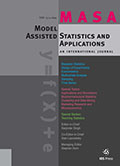Authors: Dihidar, Kajal
Article Type:
Research Article
Abstract:
In estimating the proportion of people bearing sensitive matters like habits of tax evasion, drunken driving, etc. in a given community, it is difficult to obtain trustworthy data through direct queries. To overcome this difficulty, Warner [29] introduced randomized response techniques to estimate the proportion of people bearing such a stigmatizing or sensitive characteristic in a given community. Since then, several researchers have extended and applied this technique in various ways, for instance, Greenberg et al. [13], Horvitz et al. [16], Mukerjee [23], Ljungqvist [20], Christofides [10], Singh and Grewal [26], and many others. In many areas of the RR-related
…activities, the sample selection is traditionally by simple random sampling (SRS) with replacement (WR). Keeping in mind that the general large scale sample surveys usually involve the unequal probability sample selection, subsequently many researchers have enriched the RR-related literature by extending in unequal probability sampling (see Chaudhuri et al. [5], Dihidar [12], Chaudhuri and Dihidar [6]). Hanurav [14], Rao [25], Chaudhuri and Arnab [4] had compared some unequal probability sampling strategies for estimating the population mean of a quantitative variable in direct surveys under a super-population model. In this paper, we consider the problem of estimating sensitive population proportion by unequal probability sampling using the pioneering randomized response techniques due to Warner [29], Mangat and Singh [22], Christofides [9], Chaudhuri and Mukerjee's [7] forced response model, Kuk's model [18], Singh and Joarder's [27] unknown repeated trial model and compare the Horvitz-Thompson's [17] and Murthy's [24] strategies under the super population model as proposed in Lanke [19]. It is shown that under this model-cum-design based approach, Murthy's strategy performs better than Horvitz-Thompson's strategy.
Show more
Keywords: Population proportion, unequal probability sampling, super population model, model-cum-design based approach
DOI: 10.3233/MAS-150334
Citation: Model Assisted Statistics and Applications,
vol. 10, no. 4, pp. 299-307, 2015
Price: EUR 27.50





